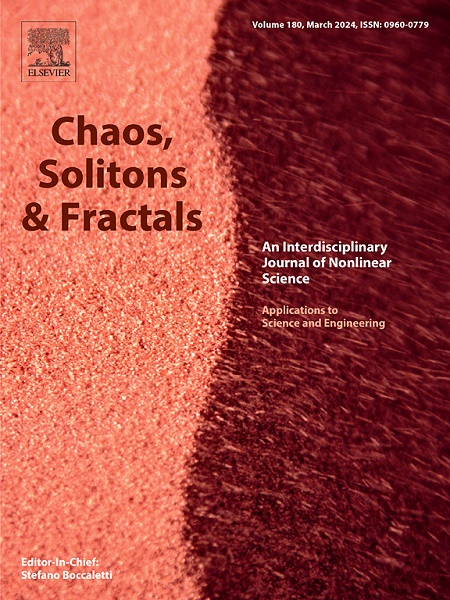Measuring complex causality and high-order interactions: An extended transfer entropy spectrum approach
IF 5.6
1区 数学
Q1 MATHEMATICS, INTERDISCIPLINARY APPLICATIONS
引用次数: 0
Abstract
Classical causal networks between complex systems are constructed based on causal interactions between pairs of systems. However, complex causal relationships involving three or more systems (e.g., indirect causality, common causality, and synergistic causal effects) and between specific system components (e.g., low-frequency components and high-frequency components) tend to have important effects on the systems. In this paper, we propose Fourier-domain conditional transfer entropy spectrum and Fourier-domain high-order transfer entropy spectrum to measure complex causality at different frequencies and different time periods. The former can distinguish indirect causality and common causality, and the latter can identify synergistic causal effects. Using this method, we construct a direct causal structure matrix that enables the observation of the causal structure of multiple systems across various frequency bands and time periods. This approach is validated through experiments using synthetic data. The application of our method to physiological networks described by polysomnography highlights its ability to detect latent causality within specific frequency bands, providing insights into the complex causal relationships inherent in sleep stages. Notably, our approach is effective in identifying direct causality within intricate causal networks, showcasing its practical applicability in understanding physiological interactions. Furthermore, the study of brain activity during motor imagery or motor execution demonstrates that, when extended to multivariate systems, the method can identify synergistic effects among different brain regions, emphasizing its potential in neuroimaging applications. These findings highlight the potential of this approach for clinical applications, particularly in understanding the biological significance of causal interactions across different frequency bands.
测量复杂因果关系和高阶相互作用:一种扩展的传递熵谱方法
复杂系统之间的经典因果网络是基于系统对之间的因果相互作用而构建的。然而,涉及三个或更多系统的复杂因果关系(例如,间接因果关系,共同因果关系和协同因果效应)以及特定系统组件之间的因果关系(例如,低频组件和高频组件)往往对系统产生重要影响。本文提出了傅立叶域条件传递熵谱和傅立叶域高阶传递熵谱来测量不同频率和不同时间段的复杂因果关系。前者可以区分间接因果关系和共同因果关系,后者可以识别协同因果关系。利用这种方法,我们构建了一个直接因果结构矩阵,使我们能够在不同的频带和时间段观察多个系统的因果结构。通过实验验证了该方法的有效性。将我们的方法应用于多导睡眠图描述的生理网络,突出了其在特定频带内检测潜在因果关系的能力,为了解睡眠阶段固有的复杂因果关系提供了见解。值得注意的是,我们的方法在复杂的因果网络中有效地识别直接因果关系,展示了其在理解生理相互作用方面的实际适用性。此外,对运动想象或运动执行过程中大脑活动的研究表明,当扩展到多变量系统时,该方法可以识别不同大脑区域之间的协同效应,强调了其在神经成像应用中的潜力。这些发现突出了这种方法在临床应用中的潜力,特别是在理解不同频段因果相互作用的生物学意义方面。
本文章由计算机程序翻译,如有差异,请以英文原文为准。
求助全文
约1分钟内获得全文
求助全文
来源期刊

Chaos Solitons & Fractals
物理-数学跨学科应用
CiteScore
13.20
自引率
10.30%
发文量
1087
审稿时长
9 months
期刊介绍:
Chaos, Solitons & Fractals strives to establish itself as a premier journal in the interdisciplinary realm of Nonlinear Science, Non-equilibrium, and Complex Phenomena. It welcomes submissions covering a broad spectrum of topics within this field, including dynamics, non-equilibrium processes in physics, chemistry, and geophysics, complex matter and networks, mathematical models, computational biology, applications to quantum and mesoscopic phenomena, fluctuations and random processes, self-organization, and social phenomena.
 求助内容:
求助内容: 应助结果提醒方式:
应助结果提醒方式:


